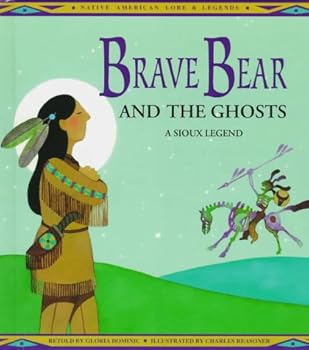Brave Bear and the Ghosts: A Sioux Legend
(Part of the Native American Lore & Legends Series)
Select Format
Select Condition 
Book Overview
Young Brave Bear outwits four ghosts who are trying to haunt, him in this humorous Sioux legend. This description may be from another edition of this product.
Format:Library Binding
Language:English
ISBN:0865934290
ISBN13:9780865934290
Release Date:January 1997
Publisher:Rourke Publishing (FL)
Length:47 Pages
Weight:0.70 lbs.
Dimensions:0.4" x 8.3" x 9.3"
Age Range:9 to 10 years
Grade Range:Grades 4 to 5
Customer Reviews
1 rating
Wondeful illustrations of the ghosts in this first rate Lakota legend
Published by Thriftbooks.com User , 18 years ago
I have liked Charles Reasoner's artwork for these Native American Lore & Legends series books, but "Brave Bear and the Ghosts: A Sioux Legend" is my new favorite because of the way he does the ghosts. You get a hint of it from the cover painting with Brave Bear on the left and a ghost riding a ghost horse on the right. But the ghosts are, for the most part, more purple than what you see. Reasoner's figures usually do not have mouths and for eyes just the little slits we would all associate with Snoopy in the "Peanuts" cartoons. This time, there are mouths for these figures, but mouths that suggest the space between the cranium and the jaw on a skull. The eyes are still little slits, but they have a dark circle around them. The shades of purple are also really cool. Too bad they are the villains in the story, retold by Gloria Dominic. It is always winter in the land of ghosts and as they sit around talking about how much fun it is to scare people one of them tells of Brave Bear, a warrior and hunter who laughs in the face of death. The ghosts make a bet that the first ghost to scare Brave Bear will win the ghost horses of the others. But when they go after Brave Bear to win their bet he keeps making bets with them and winning their horses. This is fairly predictable, since Brave Bear is the hero of the tale. But what is great are all the clever ways that Brave Bear bests each of the ghosts. They are as cool as the illustrations of the ghosts, which is why this Sioux story has become one of my favorites. Plus, there is a punch line at the end that will appeal to young readers as well. The back of the book talks about the Sioux, which is problematic because ever since "Dances With Wolves" most of us have learned that these people called themselves the Lakota (or Dakota or Nakota), and that the word "Sioux" is the Ojibwa word for "snake." That is covered in the back of this book, but then the book continues to use the derogatory term, but without justifying why (if kids can learn to call a brontosaurus an apatosaurus, they can learn to call the Sioux the Lakota). Is the point here that racism is okay if one Native American tribe hangs a derogatory name on another as opposed to having it done by the settlers? This book is going to be the first opportunity for many young readers to find out about this particular society, so this really should have been a Lakota (or Dakota or Nakota) legend. The back of the book covers the homeland, food and clothing, and where the people called in this book the Sioux live today. Young readers will also find a Glossary of terms from "akicita" to "travios," and a list of important dates that begins with the 1700s when these people became expert horsemen and 1979 when the U.S. Supreme Court awarded them $105 million for the taking of their lands, which settled a legal action begun in 1923. This section is illustrated with historic photographs of these people and contemporary shots of artifacts.




